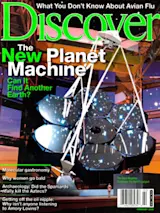MAKING SENSE OF SPACE
In December's "Field Guide to the Entire Universe," Corey S. Powell says that we have no idea how to make sense of 70 sextillion stars, not to mention dark matter and dark energy. Science wants everything verified visually or mathematically. We now use fudge factors called dark energy and dark matter, amounting to 96 percent of the universe, to make our formulas work. It's time we put our calculation of the universe, along with intelligent design, into the humanities rather than science. I'll bet the answers to both will be at a dead heat when they eventually enter the science curriculum.
Duane LaMoreauxCommerce, Michigan
Dark matter may be an enigma, but it has earned its place in the science classroom. The existence of dark matter is inferred from several independent empirical observations, including the rotations of galaxies, the distribution of hot gas in galaxy clusters, the gravitational lensing of light in galaxy clusters, and the distribution of the cosmic microwave background. Intelligent design, in contrast, is based on a lack of evidence (anything we don't understand just gets attributed to an unknown designer). Also, several teams of physicists are hard at work searching for direct evidence of dark-matter particles; those experiments could confirm the existence of dark matter. To the best of my knowledge, nobody is engaged in scientific experiments to isolate the intelligent designer and thereby prove or disprove his (its?) existence. —Corey S. Powell
In "Field Guide" you state the location of quasar HE 0151-4326 as being 10 billion light-years away in the constellation Phoenix, with an age of 3.5 billion years. I'm just a simple country boy, but doesn't this quasar need to age another 6.5 billion years before its original light would be visible to us?
Thomas DavisBossier City, Louisiana
Matters of age and distance always become confusing when you're talking about objects that are billions of light-years away. The quasar's light has taken 10 billion years to reach us, which is another way of saying that the light has traveled 10 billion light-years on its journey—hence the statement that the quasar is 10 billion light-years away. The universe today is about 13.7 billion years old, so if the light from the quasar has been traveling for 10 billion years, the quasar was 3.7 billion years old when the light began. We rounded that off to 3.5 billion years for two reasons. First, the ages are approximate. Second, we know that quasars and galaxies did not form until at least a couple of hundred million years after the Big Bang. Roughly, then, this is the chronology: The quasar formed around 200 million years after the Big Bang. The light we see was emitted about 3.5 billion years later, then spent 10 billion years on its journey to us. —The editors
HOW BEST TO STUDY OURSELVES?
Psychologists Joachim Krueger and David Funder's call for a reorientation in social psychology that stresses the goodness of people ["Why Do People Behave Nicely ?" December] is naive and irresponsible. In medicine, we learn what constitutes "good" health by studying disease in order to prevent, treat, and eliminate it. But due to the wish to flatter ourselves, the science of pathology has failed to acknowledge the pathological behavior of the human species toward itself and other forms of life, focusing exclusively on other species that obstruct human desires and needs. I've argued against this homocentrism in The Pathology of Man: A Study of Human Evil (Charles C Thomas, 2005), showing in psychological terms how—through ecology, war, genocide, terrorism, hatred, and moral stupidity—the human species acts destructively not only toward many other species but also toward itself. What is needed desperately, if this century is not to dwarf the last as the bloodiest in history, is a scientific study of human pathology. As long as we are blind to our own malignancy, we cannot initiate positive change.
Steven James Bartlett Visiting scholar in psychologyWillamette UniversitySalem, Oregon
what lives inside
I enjoyed Jessica Snyder Sachs's November article "Are Antibiotics Killing Us?" However, I'd like a clarification of one point. The illustration showing "Your Body's Abundant Bacteria" states that the colon contains over two pounds of bacteria. I mentioned this to my friend John Fordtran, an internationally renowned gastroenterologist of the first rank (he coedited the definitive textbook), and he says, "No way." The average human cannot have this much bacteria weight in the large bowel.
Michael Emmett Chairman of Internal MedicineBaylor University Medical CenterDallas, Texas
Drs. Emmett and Fordtran have caught me repeating an oft-cited yet unsubstantiated medical factoid. Here are some other estimates: In Life on Man (Viking, 1969), microbiologist Theodor Rosebury estimates that the microbial population of the human body could be packed into "something hardly bigger than a soup can," all but a thimbleful of this coming from the gut. Your typical can of condensed soup weighs about two-thirds of a pound. In his newly definitive Microbial Inhabitants of Humans (Cambridge, 2005), Michael Wilson states that bacteria make up 55 percent of the solids in the quarter pound of feces an average person produces on an average day. Wilson's estimate seems a bit low, but perhaps it's based on a low-fiber British diet. —Jessica Snyder Sachs
ERRATA
In "Futuristic Fruits of the Loom" [Reviews, September], we stated that the landing of the Pathfinder probe on Mars in 1997 was "humankind's first imprint on the soil of a planet other than its own." Our subsequent erratum gave this distinction to the twin Viking crafts that landed on Mars in 1976. In fact, the crash landing of the U.S.S.R.'s Venera 3 on the surface of Venus on March 1, 1966, marks the first impact of a spacecraft on another planet's soil.














